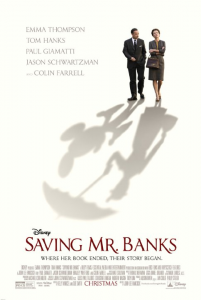
 One of the themes of 2013 at the movies is the conflict and interaction between fact and fiction. Perhaps, director David O. Russell said it best in a statement at the beginning of his excellent film “American Hustle,” asserting that some of the things in his movie actually happened.
One of the themes of 2013 at the movies is the conflict and interaction between fact and fiction. Perhaps, director David O. Russell said it best in a statement at the beginning of his excellent film “American Hustle,” asserting that some of the things in his movie actually happened.
And, it seems that one of the main criticisms of Disney’s “Saving Mr. Banks” is that some of it is not true. In fact, in his review, my former television cohost, Jeff Marker, has gone so far as to suggest that most of it is, in fact, fiction. Marker’s well-made point is that it is all part of the Disney spin machine, protecting their very lucrative brand. And while this may be true, I still liked the film. In fact, I consider it one of the year’s best.
To set the record straight, “Saving Mr. Banks” is a narrative feature film that is largely a contrived work of fiction. The movie is manipulative and schmaltzy. It is not a documentary, nor does it, at any point, hide its particular perspective. Disney’s name is all over the film and that is disclaimer enough.
To put a fine tip on it, ”Saving Mr. Banks” is not a narrative about P.L. Travers, rather, it is about Walt Disney and how he saw the Travelers story. In fact, the movie ironically but, perhaps, indirectly, points out that Walt Disney believed his own hype. In contrast to Travers stark view of the real world, Disney looked at the world through animated rose-colored glasses. And what joy that perspective has brought so many for so many years.
I make documentary films. And one of the reasons why it is discouraged for documentarians to pay their subjects is that the financial transaction may adversely affect the way the story is reported. Most documentaries are not, these days, objective news reporting exercises. And this year some of the documentary films tended to blur the lines. Sarah Polley’s “Stories We Tell” gave us footage that, at least, on the surface purported to be home movies. Later, we learn that the unbelievably on the nose home movies that are featured in Polley’s excellent film were in fact dramatic re-creations. The documentary “The Act of Killing” takes things even farther by collaborating, in a way, with its subjects and giving them an opportunity and resources to reenact their despicable and horrifying acts of murder and torture. It is an unbelievably difficult film to watch. Is it a documentary? I think so. Others may disagree.
In “Saving Mr. Banks,” the story uses author P.L. Travers’ difficult childhood in Australia as a possible explanation for how she acted later in life particularly with regard to Walt Disney and his adaptation of “Mary Poppins,” her famous series of books. “Banks” is a work no different than “The Queen,” or, say, Oliver Stone’s “Nixon,” for example, which are films that have taken real world events and imagined the goings on behind closed doors. This means that some of the stuff in “Banks” just didn’t happen, or happened differently in real life. I think the sophisticated audience that “Banks” is targeted at will understand the difference.
Perhaps what rankles some critics, like Marker, is that Disney ultimately profits with “Banks” from the Travers story once again by exploiting her. I have no idea what contract Travers cut with Disney, but one of the things that is absolutely accurate in the film is that Travers chief motivation for working with Disney was to save herself from financial ruin. And, in fact, it seems that given the incredible success of Disney’s “Mary Poppins” film, Travers no longer had to worry about paying her bills. I know more than one writer who would like to have such an opportunity. My cynical approach here focusing on the financial and contractual obligations that were forged both on screen and in real life exposes the bottom line: money matters. And the artistic and narrative merit of the “Mary Poppins” film could not have been achieved without the proper financial backing.
And because “Banks” is so well-produced, it is an effective and extremely well made film from top to bottom. Tom Hanks shines as Disney delivering another award worthy performance in 2013 (the other in “Captain Phillips”). But in fantastic form is Emma Thompson, who is never ever bad, just often underused. Director John Lee Hancock (“The Blind Side”) working from a script by Kelly Marcel and Sue Smith once again gets more than he bargained for from a strong female presence on screen. Thompson playing the frigid and troubled artist will have you in tears, there is no doubt.
There is a 2013 documentary called “Cutie and the Boxer” worth mentioning here. In that terrific and touching film, the artist, Ushio Shinohara, lives his life in an alcohol infused carefree manner leaving his wife and ultimately their son to pick up the pieces. He hides behind art and his pursuit of his particular type of art as the reason for not being successful. The toll this takes on his relationship is profound. It all comes down to sacrifice for what you believe in. Is it worth it? In some rare moments, the financial motivations coincide with the artistic ones. Regardless what you think of “Saving Mr. Banks,” my feeling is that in this case the two coincide well.
Read Jeff Marker’s review HERE.

